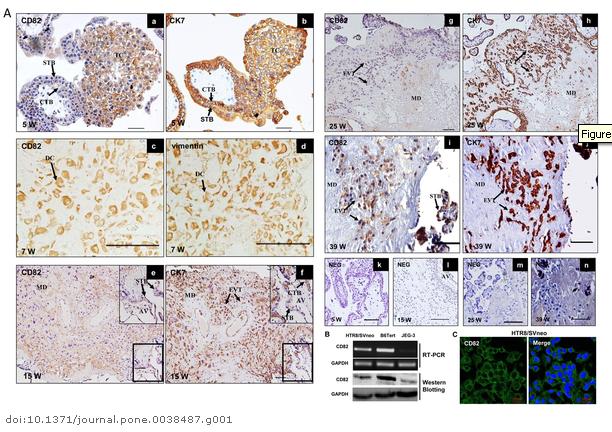User:Z3333794: Difference between revisions
| Line 38: | Line 38: | ||
'''Identify a protein associated with the implantation process, including a brief description of the protein's role.''' | '''Identify a protein associated with the implantation process, including a brief description of the protein's role.''' | ||
The Rac-1 protein belongs to a family of small GTPase binding protein called the RAS superfamily. This protein plays an important role in various cellular processes like cell motility, cellular growth, cell cycle and also cell-cell adhesion. Studies done by Grewal et.al., 2008 demonstrate that the invasion of the human embryonic tropoblast layer into the human endrometrial stromal cells requires mediation by the Rac-1 protein. Increased motility of the stromal cells increases the chances of implantation and an increased expression of Rac-1 activation corresponds with increase in motility. Rac-1 also works by down-regulating RhoA protein which is also important to promote embryo invasion. Since, successful implantation is imperative for pregnancy and fertility the role of Rac-1 is somewhat central to the process of implantation. | The Rac-1 protein [[http://www.ncbi.nlm.nih.gov/protein/NP_008839.2]] belongs to a family of small GTPase binding protein called the RAS superfamily. This protein plays an important role in various cellular processes like cell motility, cellular growth, cell cycle and also cell-cell adhesion. Studies done by Grewal et.al., 2008 demonstrate that the invasion of the human embryonic tropoblast layer into the human endrometrial stromal cells requires mediation by the Rac-1 protein. Increased motility of the stromal cells increases the chances of implantation and an increased expression of Rac-1 activation corresponds with increase in motility. Rac-1 also works by down-regulating RhoA protein which is also important to promote embryo invasion. Since, successful implantation is imperative for pregnancy and fertility the role of Rac-1 is somewhat central to the process of implantation. | ||
<pubmed> 18838676 </pubmed> | <pubmed> 18838676 </pubmed> | ||
Revision as of 14:18, 7 August 2012
Lab Attendance
Lab 1 --Z3333794 10:59, 25 July 2012 (EST)
Lab 2 --Z3333794 10:02, 1 August 2012 (EST)
Lab Exercises
Lab 1
Identify the origin of In Vitro Fertilization and the 2010 nobel prize winner associated with this technique and add a correctly formatted link to the Nobel page.
The roots of InVitro Fertilization (IVF) and Embryo Transfer (ET) dates back to the early 1890s where Walter Heape a dedicated professor and physician at the University of Cambridge in England whereby he reported the first case of embryo transplant in rabbits. He then went on to do more research in the field of reproduction on a variety of animal species. IVF history
IVF worldwide also articulates that the first in vitro fertilization of human oocytes was carried out in 1965 in John Hopkins Hospital, USA by Edwards and Jones and the first IVF pregnancy occurred in 1973 in the Melbourne, Australia by researchers Wood and Leeton. The pregnancy led to a miscarriage and the first IVF baby was born in England on 25th July 1978, 5 years later. IVF history
The 2010 Nobel prize in Physiology and Medicine was awarded to Robert G. Edwards for development of in vitro Fertilization. His contribution to embryology made a worldwide impact as it became a viable way to overcome infertility. [Nobel Prize Winner 2010]
Identify and add a PubMed reference link to a recent paper on fertilisation and describe its key findings (1-2 paragraphs).
In Vitro Fertilization technology has not only impacted humans as a way to overcome infertility but has majot implications for the animal society as well. It is used in breeding practices throughout the world to breed the best quality animals. To make sure the treatment is cost effective it is imperative that the process of IVF leads to a successful pregnancy and as a result birth. Research carried by Jimenez et.al., 2011 focuses at investigating the link between thickness of zona pellucida fertilization, embryo implantation and birth. By using video chromatography their team successfully concluded that the thickness of zona pelucida greatly impacted the fertilization process and transplantation but did not significantly impact in birth.
<pubmed> 22607772 </pubmed>
Lab 2
Adding an Image with the class
Online Lab Questions
Upload an image from a journal source relating to fertilization or the first 2 weeks of development.
Identify a protein associated with the implantation process, including a brief description of the protein's role.
The Rac-1 protein [[1]] belongs to a family of small GTPase binding protein called the RAS superfamily. This protein plays an important role in various cellular processes like cell motility, cellular growth, cell cycle and also cell-cell adhesion. Studies done by Grewal et.al., 2008 demonstrate that the invasion of the human embryonic tropoblast layer into the human endrometrial stromal cells requires mediation by the Rac-1 protein. Increased motility of the stromal cells increases the chances of implantation and an increased expression of Rac-1 activation corresponds with increase in motility. Rac-1 also works by down-regulating RhoA protein which is also important to promote embryo invasion. Since, successful implantation is imperative for pregnancy and fertility the role of Rac-1 is somewhat central to the process of implantation.
<pubmed> 18838676 </pubmed>

